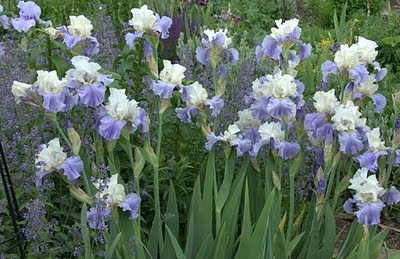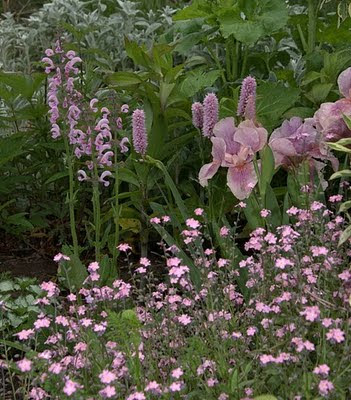
One of the fine attributes of Louisiana irises is their foliage. Along the Gulf Coast and in much of the country, the green leaves are handsome in winter. From fall when the new growth cycle begins and through the bloom season in spring, Louisianas are a welcome addition to the deciduous garden. Louisiana iris foliage is coming on and greening up as many other plants are going to sleep.
In cold areas with snow cover, Louisianas are hidden until spring. The plants are cold hardy and will emerge with warmer weather. But they can't provide the winter green that they do farther south. On the other hand, they are less likely to exhibit the scruffies that can occur in the long hot summers. In the lower South, the hot, often-dry weather between the end of bloom season in late April and the start of new growth in September can take its toll on the foliage. In the cold north, there is not as much time between bloom and snow.
Those summer scruffies are the flip side of Louisiana irises' fine foliage. The irises can head into a decline, and a very few may go entirely dormant by late summer. It is not uncommon to see a patch of Louisianas in July or August with partly yellowed foliage and without strong new growth in the center of the fan. It is not attractive, and in a mass planting can be a discouraging display.
I have found that declining summer foliage is not inevitable. The key seems to be consistent moisture. In the New Orleans area, we average 60 inches of rainfall a year. I used to think that this was plenty. These things are native here, right? So why worry too much about watering unless they irises are in obvious need? Well, because irises don’t respond to averages. There are often significant periods of drought interspersed with afternoon showers and tropical storms.
Once Louisiana irises show that they have been too dry, the slide toward dormancy has already begun, and it is difficult to reverse. When growth has been interrupted by insufficient water, it will not generally resume with much vigor until fall. If the foliage is cut back at that point, some new growth will be triggered -- and the plants certainly will look better -- but they will not recover to their same lush, spring-like form.
If Louisiana irises are never allowed to get too dry, you can enjoy good green foliage throughout the summer. If grown in beds, an irrigation system is a solution, and it can be as simple as a timer on an outside faucet connected to inexpensive sprinklers. It’s not necessary to pour a large volume of water on the irises. Just keep them consistently moist. A little shade and light fertilizing after bloom is also a plus. Of course, Louisianas can be grown in water culture, in a pond or bog, and then the problem of inadequate moisture never arises.
Some varieties, especially those with I. brevicaulis in their background, may have a greater tendency to decline in summer. No solution is perfect, and even with the best cultural conditions it will always be necessary to spruce up the plants, removing the inevitable yellowed blade.
No one does this in the wild, of course, and the irises survive just fine. But if you come across a patch of fulvas by the roadside in mid-summer, they are not likely to look good. If it has not rained for a while or if they are growing in harsh full sun, they will have yellow and dead leaves and often they are covered with rust. There is no one to keep them watered, to tidy their appearance, or to discard fungus infected blades. They are on their own and the government won’t help, unless one considers the spraying of herbicides helpful. That does solve the problem in a different manner.














